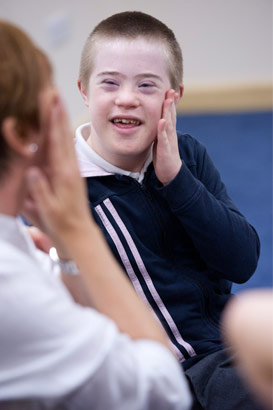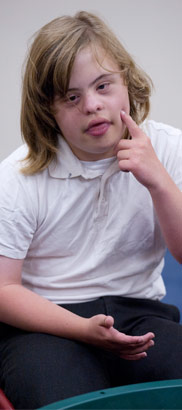
Communication development includes listening and comprehension as well
as speech and non-verbal communication.
The process of communication development in children with developmental
disabilities is
fundamentally similar to the process of communication development in typical
children. However, it is also more variable in timing, formal and functional
outcomes, and the need for specific instruction to support the developmental
process
(Kaiser et al, 2001).
the focus

The following slides focus on a language and communication issue with Down's syndrome as the focus disability. This disability was chosen as it often co-occurs in children with CLDD. Background information about the language and communication developmental area can be found at Level B.
For children with Down's syndrome, communication development has been linked to symbolic play and symbolic functioning/comprehension
(O'Toole and Chiat, 2006).
An understanding of pre-linguistic predictors
of language (the period of development before a child has a linguistic system
for acquiring language) will help teachers to identify and assess language
delay early (Watt et al, 2006).
For further information on Down's syndrome have a look at the following
links:
'Down syndrome'.
Early Years Education Information Sheet
Information for Parents: Down syndrome Annesley: DCSF Publications.
a holistic approach

It can be argued that the ultimate goal of speech
intervention is to bring about correct production of speech sounds resulting
in intelligible conversational speech within a child's milieu ... However,
other similarly important goals may be to enhance a child's participation
in social interaction, to increase self-esteem...
McLeod and
Bleile, 2004
It is important to remember that communication is about
establishing
and maintaining social links as well as the production of speech sounds.
Regardless of type of sign language...
different
types of simultaneous communication facilitated speech and oral language
production when used with children with little or no language behavior.
Dunst et al, 2011
Attention to how a child's gesture develops can:
- Provide evidence of symbolic development;
- Guide developmentally appropriate
intervention goals; - Show which concepts a child is communicating about and has an emerging understanding of.
(Capone and McGregor, 2004)

Functions of gestures/body language include communication, compensation, and transition to spoken language. They are used in:
- Social convention (eg bye-bye);
- Pointing for joint attention;
- Progressing a play scenario;
- Expressing emotion, etc.
(See: Capone and McGregor, 2004)
Signs are practiced at every opportunity and taught...
[formally and informally] within groups. Many...are learned through fingerplays
and songs.
Foreman and
Crews, 1998
Children with Down's syndrome with developmental ages of 7-18 months
enrolled in a Toddler Sign Programme were 'able to use signs more often
than words to meet communicative needs'
(Capone and McGregor, 2004).
Two well-known signing systems are Makaton and Signalong.
- Always use speech with signing.
- Use signing yourself.
- Sign clearly and so it can be seen.
- Sign the information in picture books.
- Teach signs for objects, actions and describing.
(See: Early Support, 2010)
with Down's syndrome (2)

Without manual scaffolding, children may miss crucial opportunities for
communication and language learning.
Teachers and families need to:
- Use gesture/signing cues alongside spoken scaffolds;
- Be alert to the child's initiation of communication via gesture.
Seven-year-olds with Down's syndrome responded better, focused for longer and completed tasks more successfully when gesture was used alone or in combination with speech.
(See: Capone and McGregor, 2004)
When mothers did not respond to [children's] gestured communication,
children did not re-initiate their messages.
Capone and McGregor, 2004
It is important to take note of and build on how children with SLD/PMLD/CLDD
use gesture so that the smallest attempts to communicate can become the
foundation for greater skill and confidence.

Baksi, L. and Freeman, K. (2008) Development in practice: speech and language
activities for preschool children with
Down syndrome, Down Syndrome Research
and
Practice, 12 (2), 130-131.
How to use the journal
Roberts, J.E., Price, J. and Malkin, C. (2007) Language and communication development in Down syndrome, Mental Retardation and Developmental Disabilities Research
Reviews, 13, 26-35.

Attitudes to makaton in the ages of integration and inclusion, International Journal of Special Education, 24 (2), 93-102.
Marder, L. and Cholmain, C.N. (2010) Promoting language development for children with Down's syndrome, Current Paediatrics, 16 (7), 495-500.